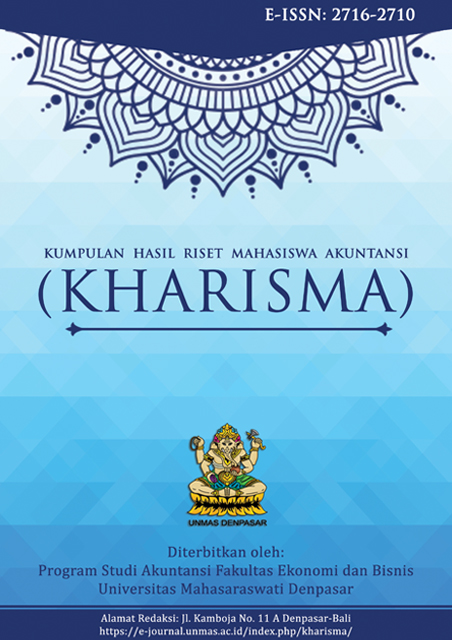Pengaruh Profitabilitas, Leverage, Likuiditas, Ukuran Perusahaan Dan Kepemilikan Institusional Terhadap Managemen Laba Pada Sub Sektor Makanan Dan Minuman Di Bursa Efek Indonesia Tahun 2020-2022
Keywords:
Earnings Management, Profitability, Leverage, Liquidity, Company Size, Institutional Ownership.Abstract
Earning management is an effort or activity of company management in the process of preparing financial reports for external parties that results in the rise and fall of company profits, this is done with the aim of improving and managing financial information according to the company's wishes. This study aims to examine the effect of profitability, leverage, liquidity, company size and institutional ownership on earnings management in food and beverage sub-sector companies on the Indonesia Stock Exchange in 2020-2022. Sample selection using purposive sampling, data analysis techniques used in this study using multiple linear analysis. The data population in this study is food and beverage sub-sector companies listed on the Indonesia Stock Exchange in 2020-2022 totaling 32 companies. The sample in this study was 22 companies with a total of 66 observations. The results of the study showed that the variables of profitability and institutional ownership had an effect on earnings management, while the variables of leverage, liquidity and company size had no effect on earnings management.
References
Dechow, P., Sloan, R. & Sweeney, A. (1995). . Detecting Earnings Management. The Accounting Review, 70,.
Fatmasari, S. (2016). Pengaruh Profitabilitas, dan Leverage Terhadap Manajemen Laba pada Perusahaan Manufaktur Terdaftar di Bursa Efek Indonesia Tahun 2012-2014. Jurnal Perbanas Surabaya, 53(9), 1689–1699.
FASB. 1978. Statement of Financial Accounting Concepts No. 1 Objectives of Financial Reporting by Business Enterprises. Connecticut: Stamford
Ghozali, I. (2018). ‘Aplikasi Analisis Multivariate dengan Program IBM SPSS.’, Edisi 9).
Horne, V. J., & Wachowicz, J. M. (2009). Fundamental of Financial management.
Jensen, M.C. and Meckling. (1976). Theory ofThe Firm : Managerial Behaviour, AgencyCost and Ownership Structure. Journal ofFinance Economics 3, Page : 305 – 360. Journal OfFinance Economics 3, 3, 305–360.
Juanda, A. (2012). Kandungan Prinsip Konservatisme Dalam Standar Akuntansi Keuangan Berbasis Ifrs (International Financial Reporting Standard). Jurnal Humanity, 7(2), 24–34.
Kasmir. (2017). Analisis Laporan Keuangan.
Mayliana, C. (2023). Pengaruh Likuiditas , Leverage , Profitabilitas , Dan Ukuran Perusahaan Terhadap Manajemen Laba Perusahaan Pertambangan Yang Terdaftar Di Bursa Efek Indonesia ( Bei ) Periode 2020-2022. Jurnal Manajeman, Bisnis Dan Akuntansi, 2(3), 111–123.
Moses, D. O. (1997). Income Smooting and Incentives: Emprical Using Accounting Changes.
Skripsi, The Accounting(259-377.).
Paramitha, D. K., & Idayati, F. (2020). Pengaruh Profitabilitas, Likuiditas, Ukuran Perusahaan Terhadap Manajemen Laba. Jurnal Ilmu Dan Riset Akuntansi (JIRA), 9(2), 1–18.
Safitri, D. P., & Triyonowati. (2015). Analisis pengaruh kinerja keuangan terhadap manajamen laba pada perusahaan perbankan. Jurnal Ilmu Dan Riset Manajemen, 4(1), 1–17.
Sugesti, L. (2024). Pengaruh Leverage, Kepemilikan Asing dan Kepemilikan Keluarga terhadap Manajemen Laba pada Sektor Makanan dan Minuman yang Terdaftar di Bursa Efek Indonesia pada Tahun 2016-2019.
Watts, Ross L. and Zimmerman, Jerold L. (1986). Positive Accounting Theory. Ross L. Watts, Jerold L. Zimmerman, Positif Accounting Theory, Prentice-Hall Inc. Available at SSRN:
Downloads
Published
Issue
Section
License

This work is licensed under a Creative Commons Attribution-ShareAlike 4.0 International License.



